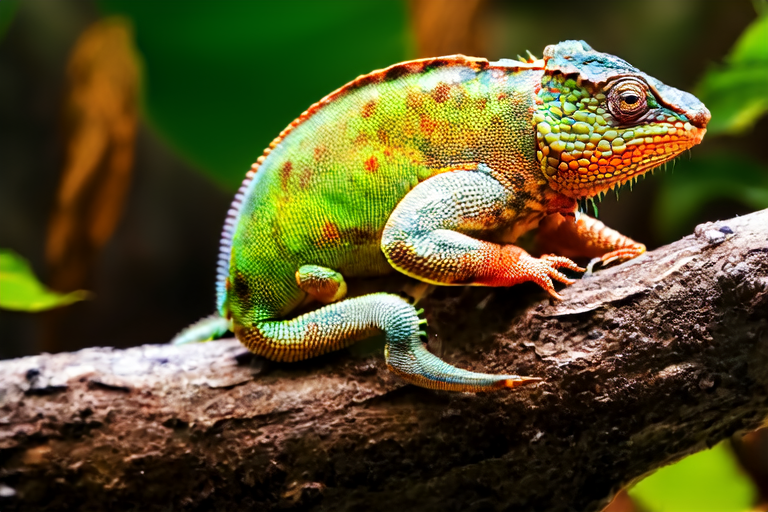Comprehensive Guide to Chameleon Care
Introduction
Welcome to this comprehensive guide on chameleon care! Chameleons are fascinating reptiles known for their unique abilities to change color and blend into their surroundings. Proper care requires understanding their specific needs regarding habitat, diet, and health. This guide will cover essential topics to ensure your chameleon thrives in captivity.
Habitat Setup
Temperature
Chameleons require a temperature gradient within their enclosure to thermoregulate effectively. The basking spot should reach between 85-95°F (29-35°C) during the day, while the cooler side of the cage should be around 70-75°F (21-24°C). Nighttime temperatures can drop slightly but should not fall below 65°F (18°C).
Use a reliable thermometer placed at different levels of the enclosure to monitor these temperatures accurately. Heat lamps or ceramic heat emitters can be used to create the necessary warmth, ensuring they do not come into direct contact with the chameleon to prevent burns.
Humidity
Maintaining proper humidity levels is crucial for chameleons’ respiratory and skin health. Most species prefer humidity levels between 50-70%. Achieve this by misting the enclosure several times daily and using a humidifier if needed. A hygrometer helps measure humidity levels accurately.
Adequate ventilation is also important to prevent stagnant air, which can lead to respiratory issues. Ensure there is sufficient airflow without causing drafts that might chill the chameleon.
Lighting
Chameleons need full-spectrum UVB lighting to synthesize vitamin D3, which aids calcium absorption. Use a high-quality UVB bulb designed specifically for reptiles, replacing it every six months even if it still appears functional. Position the light so that it reaches the basking area, allowing the chameleon to bask within 6-12 inches of the bulb.
In addition to UVB, chameleons require exposure to natural sunlight when possible. If outdoor housing is an option, ensure the enclosure provides shade and protection from predators.
Diet and Nutrition
Chameleons are insectivores, primarily feeding on live insects such as crickets, dubia roaches, and mealworms. Offer a variety of prey items to ensure a balanced diet. Feed adult chameleons daily, offering as many insects as they will consume within about 30 minutes.
Supplement the insects with calcium and multivitamin powders before feeding them to your chameleon. Dust the insects lightly, ensuring not to overdo it. Over-supplementation can lead to health problems, so follow recommended dosages carefully.
Hydration is vital; chameleons obtain most of their water through misting and droplets on leaves. Provide a shallow water dish but monitor its cleanliness and usage, as some chameleons may not drink from it regularly.
Health Monitoring
Regularly observe your chameleon for signs of illness or stress. Healthy chameleons are alert, active, and have clear eyes and nostrils. Look out for symptoms like lethargy, weight loss, swollen eyes, or unusual discharge.
Take your chameleon to a veterinarian specializing in exotic pets for annual check-ups. They can perform fecal examinations, blood tests, and other diagnostics to catch potential issues early.
Handling Techniques
Chameleons are not social animals and do not enjoy being handled frequently. Limit handling sessions to short durations, approximately 10-15 minutes per week, to minimize stress.
When handling, support the chameleon’s body fully, avoiding excessive squeezing or pressure. Gently place it back into its enclosure after each session. Always wash your hands before and after handling to maintain hygiene.
Common Pitfalls to Avoid
- Over-handling: Frequent handling can cause undue stress, leading to health issues.
- Improper substrate: Avoid loose substrates like sand or gravel, which can cause impaction if ingested.
- Lack of enrichment: Provide branches, plants, and climbing structures to encourage natural behaviors.
- Incorrect supplementation: Follow precise guidelines for calcium and vitamin supplements to prevent imbalances.
- Insufficient ventilation: Poor ventilation can lead to respiratory infections.
Conclusion
By following this comprehensive guide, you’ll be well-equipped to provide optimal care for your chameleon. Remember that each species has slightly different requirements, so research your specific chameleon’s needs thoroughly. With dedication and attention to detail, you can ensure your chameleon leads a healthy and happy life in captivity.
